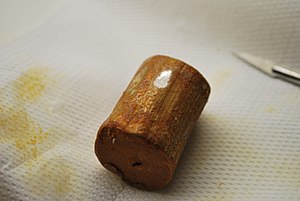
| |
| Names | |
|---|---|
| IUPAC name sodium superoxide | |
| Other names
sodium superoxide sodium dioxide | |
| Identifiers | |
| CAS Number | |
| 3D model (JSmol) | |
| ChemSpider | |
| PubChem CID | |
| RTECS number |
|
| UNII | |
| UN number | 2547 |
| CompTox Dashboard (EPA) | |
InChI
| |
SMILES
| |
| Properties | |
| Chemical formula | NaO2 |
| Molar mass | 54.9886 g/mol |
| Appearance | Yellow to orange crystalline solid |
| Density | 2.2 g/cm |
| Melting point | 551.7 °C (1,025.1 °F; 824.9 K) |
| Boiling point | Decomposes |
| Solubility in water | Decomposes |
| Basicity (pKb) | N/A |
| Structure | |
| Crystal structure | cubic |
| Thermochemistry | |
| Heat capacity (C) | 72.1 J/mol K |
| Std molar entropy (S298) |
115.9 J/mol K |
| Std enthalpy of formation (ΔfH298) |
-260.2 kJ/mol |
| Gibbs free energy (ΔfG) | -218.4 kJ/mol |
| Hazards | |
| GHS labelling: | |
| Pictograms |  
|
| Signal word | Danger |
| Hazard statements | H271, H314 |
| Precautionary statements | P210, P220, P260, P280, P303+P361+P353, P305+P351+P338 |
| NFPA 704 (fire diamond) |
 |
| Flash point | Non flammable |
| Related compounds | |
| Other anions | sodium oxide sodium peroxide |
| Other cations | Lithium superoxide Potassium superoxide Rubidium superoxide Caesium superoxide |
| Except where otherwise noted, data are given for materials in their standard state (at 25 °C , 100 kPa).
| |
Sodium superoxide is the inorganic compound with the formula NaO2. This yellow-orange solid is a salt of the superoxide anion. It is an intermediate in the oxidation of sodium by oxygen.
Preparation
NaO2 is prepared by treating sodium peroxide with oxygen at high pressures:
- Na2O2 + O2 → 2 NaO2
It can also be prepared by careful oxygenation of a solution of sodium in cryogenic liquid ammonia:
- Na(in NH3) + O2 → NaO2
Although the existence of a sodium oxide higher than peroxide was speculated since 19th century, it was not until 1948 when American chemists were able to definitely synthesize it by the latter method.
It is also produced, along with sodium peroxide, when sodium is stored under inappropriate conditions (e.g. in dirty or partially halogenated solvents).
Properties
The product is paramagnetic, as expected for a salt of the O
2 anion. It hydrolyses readily to give a mixture of sodium hydroxide, oxygen and hydrogen peroxide. It crystallizes in the NaCl motif.
References
- Hayyan, Maan; Hashim, Mohd Ali; AlNashef, Inas M. (2016-02-15). "Superoxide Ion: Generation and Chemical Implications". Chemical Reviews. 116 (5). American Chemical Society (ACS): 3029–3085. doi:10.1021/acs.chemrev.5b00407. ISSN 0009-2665. PMID 26875845.
- Stephen E. Stephanou, Edgar J. Seyb Jr., Jacob Kleinberg "Sodium Superoxide" Inorganic Syntheses 1953; Vol. 4, 82-85.
- Schechter, William H.; Sisler, Harry H.; Kleinberg, Jacob (January 1948). "The Absorption of Oxygen by Sodium in Liquid Ammonia: Evidence for the Existence of Sodium Superoxide". Journal of the American Chemical Society. 70 (1): 267–269. doi:10.1021/ja01181a083. ISSN 0002-7863.
- Sasol Encyclopaedia of Science and Technology , G.C. Gerrans, P. Hartmann-Petersen , p.243 "sodium oxides" , google books link
| Sodium compounds | |||||||||||||||
|---|---|---|---|---|---|---|---|---|---|---|---|---|---|---|---|
| Inorganic |
| ||||||||||||||
| Organic | |||||||||||||||
This inorganic compound–related article is a stub. You can help Misplaced Pages by expanding it. |